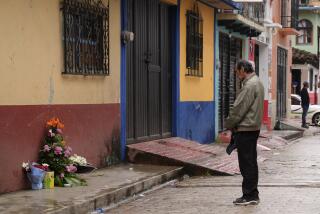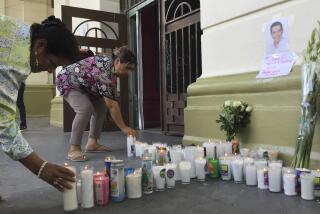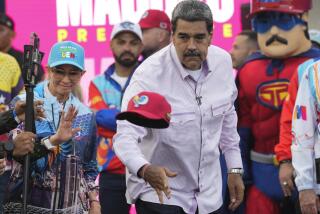Drug lord and paramilitary chief is dead, Colombia says
BOGOTA, COLOMBIA — Ending a years-long manhunt, troops in Colombia have found the corpse of Pedro “the Knife” Guerrero, one of the country’s top right-wing paramilitary leaders and drug traffickers, President Juan Manuel Santos said Wednesday.
Guerrero, whose nickname refers to the weapon he favored while terrifying peasants he suspected of aiding leftist rebels, was believed to have been mortally wounded in a gun battle Christmas morning when 120 helicopter-borne commandos of the special Junglas anti-narcotics police force raided his camp near the remote town of Mapiripan in Meta state.
Two police officers and one of Guerrero’s bodyguards were killed in the shootout, in which his forces fought back with high-caliber machine guns. Seven members of Guerrero’s inner circle were captured, including Harold Humberto Rojas Pineros, or “Crazy Harold,” Guerrero’s second in command.
In March, the U.S. Treasury Department singled out Guerrero as one of Colombia’s most powerful drug traffickers for the influence he wielded in eastern states. There he led an illegal army known by its Spanish initials ERPAC, which protected coca fields and drug export corridors. Colombian police had offered a $2.5-million reward for information leading to his capture.
Guerrero’s criminal career goes back to his days as a teenage lieutenant of Medellin drug lord Jose Gonzalo Rodriguez Gacha. He later emerged as a top leader of the “Centaurs,” one of the paramilitary militias formed in the 1990s ostensibly as self-defense forces against guerrillas. Many of the groups became leading players in cocaine trafficking.
The U.S. Drug Enforcement Administration’s Andean regional director, Jay Bergman, said the Colombian National Police-led operation was the “culmination of months of intelligence gathering.... [Guerrero] was a hardened target and an elusive fugitive employing a vast and formidable armed criminal gang with an extensive counter-surveillance mechanism.”
“The Knife” had his flamboyant side, and was also known for owning a gold-plated AK-47 and a Rolex watch and for taking meticulous care of his manicured fingernails.
In a news conference at national police headquarters, Santos said Guerrero had been responsible for 3,000 deaths. They included the 49 victims of a notorious 1997 massacre in Mapiripan, in which paramilitary troops used chain saws and machetes to kill suspected rebel sympathizers during a five-day bloodbath.
The Mapiripan killings were allegedly carried out with the knowledge of the army, and a general was later sentenced to 40 years in prison for not responding to reports of violence.
Previous attempts to capture Guerrero were frustrated by his notoriously good sources in Colombian law enforcement, who tipped him off to impending raids, according to an army officer witness who gave testimony to a special prosecutor this year.
Santos called Guerrero the “assassin of assassins” and applauded the police. “He had turned into some kind of legend, that no one would ever be able to capture,” the president said at police headquarters.
Guerrero opted not to demilitarize under former President Alvaro Uribe’s demobilization program, which saw 30,000 right-wing militia members, and most major paramilitary leaders, lay down their arms.
Almost by default, Guerrero then took control of much of the territory in eastern Colombia where the lucrative coca crop is grown and cocaine is processed and trafficked. The region is an important source of drugs shipped across the border into Venezuela and on to the U.S. and Europe.
Guerrero formed ERPAC, or the Popular Revolutionary Anti-terrorist Army of Colombia, and allied himself with drug trafficker Daniel Barrera, who remains at large. The pair ran cocaine trafficking as a sort of “franchise operation,” said Priscilla Zuniga, a researcher.
“It’s a great way to end the year,” Santos said.
More to Read
Sign up for Essential California
The most important California stories and recommendations in your inbox every morning.
You may occasionally receive promotional content from the Los Angeles Times.










